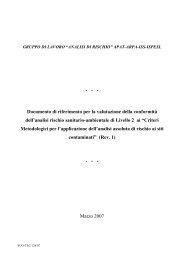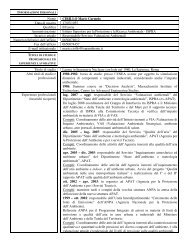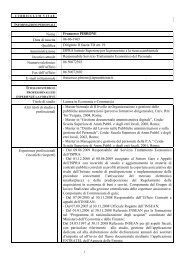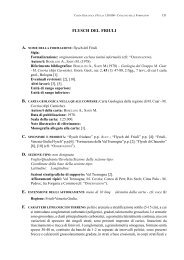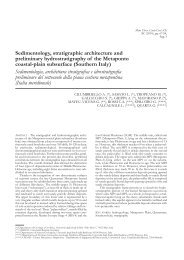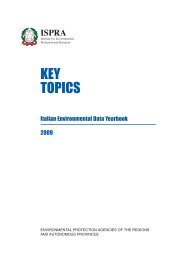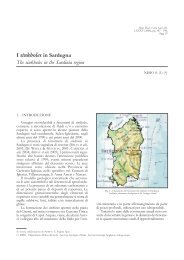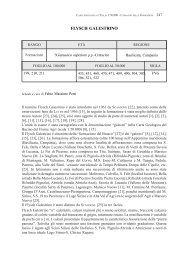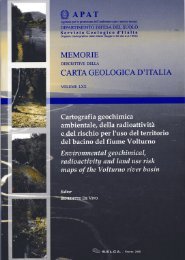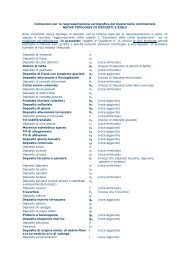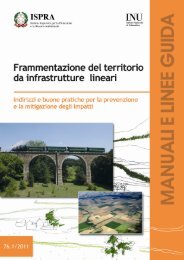Guidebook - Ispra
Guidebook - Ispra
Guidebook - Ispra
Create successful ePaper yourself
Turn your PDF publications into a flip-book with our unique Google optimized e-Paper software.
Volume n° 1 - from PR01 to B15<br />
B12<br />
B12 -<br />
Leader: M. Sandulescu<br />
basement.<br />
For the lowermost Bihor Unit, this basement consists<br />
of the medium-grade Somes Series (micaschists,<br />
amphibolites, leptynites) and the retrogressive Arada<br />
Series (chlorite-sericite-albite schists, metarhyolites),<br />
both intruded by the Muntele Mare granitic massif.<br />
The ages of the metamorphism and of the intrusion<br />
are Paleozoic.<br />
The sedimentary sequence of the Bihor Unit includes,<br />
(besides very scarce Permian) Triassic, Jurassic and<br />
pre-Senonian Cretaceous formations. The following<br />
specific lithostratigraphic features must be underlined:<br />
-development of a carbonatic platform series from the<br />
Upper Werfenian to the base of the Carnian;<br />
-absence of the major part of the Upper Triassic;<br />
-Gresten paralic facies of the Lower Jurassic;<br />
-marine sequence of the Middle Jurassic and of the<br />
base of the Upper Jurassic;<br />
-development of a carbonatic platform in the Kimmeridgian<br />
and the Tithonic;<br />
-lag of sedimentation at the base of the Cretaceous,<br />
marked by bauxites;<br />
-calcareous neritic lithofacies of the Barremian and<br />
Aptian, passing into a marly sedimentation which<br />
continues in the Turonian.<br />
The Bihor Unit corresponds to the Villàny Unit in<br />
southern Hungary and to the Tatride units in the<br />
Slovakian Carpathians, and is probably overthrust<br />
northwards onto the Tethysian Suture.<br />
Codru Nappes System. A number of nappes are overthrust<br />
from the SE onto the Bihor Unit; they correspond<br />
to the South Hungarian Bekes Realm.<br />
The first major unit, the Finiș-Gârda Nappe, has<br />
a metamorphic basement consisting of the Codru<br />
Granitoids and Migmatites, the oldest basic intrusions<br />
being pre-Hercynian (400 m. a.) according to<br />
Dallmeyer et al. (1994). As specific lithostratigraphic<br />
features, the following are to be mentioned:<br />
-large development of the Permian, with felsic ignimbritic<br />
volcanism;<br />
-complete development of the Triassic sequence, with<br />
Carpathian Keuper and Kössen facies in the Late and<br />
latest Triassic;<br />
-marine, marly-calcareous facies of the Lower<br />
Jurassic;<br />
-development of a flysch-type sequence in the Tithonian-Neocomian.<br />
The Următ Nappe is developed similarly to the Finiș<br />
Nappe, with lithofacial variations at the level of the<br />
Jurassic, which is of wildflysch type.<br />
The Dieva-Bătrânescu Nappe is characterized by:<br />
- a complex magmatism in the Permian, with mafic<br />
rocks intercalated between two rhyolitic sequences;<br />
- development of Reifling and Dachstein facies (until<br />
the Upper Norian);<br />
- a lag at the level of the Jurassic.<br />
The Moma-Arieșeni Nappe overlies all the other<br />
units including the Bihor Unit. The oldest formations<br />
of the former consists of the Lower Carboniferous<br />
Arieșeni Series (greenschists intruded by doleritic<br />
veins). The Upper Carboniferous and Permian molassic<br />
formations of reddish colour are well developped,<br />
including acidic eruptive products. The Middle and<br />
Upper Triassic formations, in calcareous facies, end<br />
with the Rhaetian.<br />
The highest nappes of the Codru System display Triassic<br />
sequences in Hallstatt and Dachstein facies.<br />
Biharia Nappes System. This group of nappes<br />
consists essentially of metamorphic formations of<br />
pre-Carboniferous age (Biharia Series: orthoamphibolites,<br />
chlorite-schists with albite porphyroblasts;<br />
Muncel Series: sericite schists, mylonitic granites,<br />
metarhyolites) overlain by the metaconglomeratic<br />
Upper Carboniferous Păiușeni Series.<br />
Post-tectogenetic cover. The nappes building up the<br />
Internal Dacides (Northern Apusenides), characterized<br />
by a Turonian principal tectogenesis (similarly to<br />
the Slovak Central Carpathians or to the Eastern Alps)<br />
are post-erosionally overlain by the Senonian Gosau<br />
Formation. The post-tectonic subduction magmatism<br />
is represented by banatites.<br />
Banatitic Late Cretaceous magmatism. In the<br />
Apuseni Mountains, an outstanding example of<br />
Late Cretaceous magmatism is the volcano-plutonic<br />
Vlădeasa Massif; a volcano-sedimentary formation is<br />
overlain by andesites, dacites and ignimbritic rhyolites,<br />
all crossed by quartz-dioritic and monzogranitic<br />
minor intrusions.<br />
Southwards, a granodioritic-granitic batholith crops<br />
out only on restricted areas and is also associated to<br />
andesitic and rhyolitic minor intrusions.<br />
Neogene magmatism. Neogene magmatic rocks in<br />
the Apuseni Mountains range in age from 14.8 to<br />
7.4 M. a., their calc-alkaline composition varying<br />
from basalt-andesites to dacites, andesites prevailing;<br />
many plot at the edge of the adakite field (Roșu,<br />
2001). They crop out along three main WNW - ESE<br />
to NW - SE trending lineaments (Brad-Săcărâmb,<br />
Stănija-Zlatna, Roșia Montană-Bucium), plus the<br />
Baia de Arieș zone.



